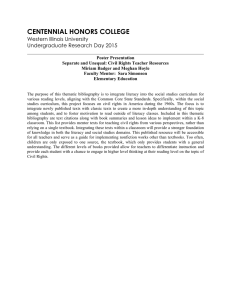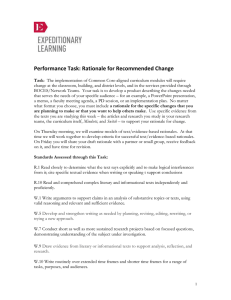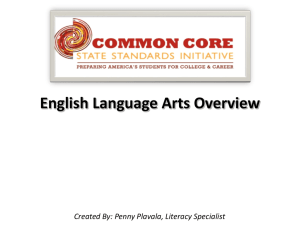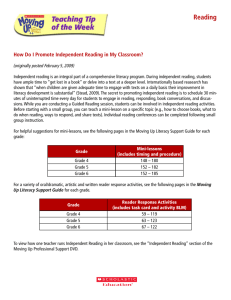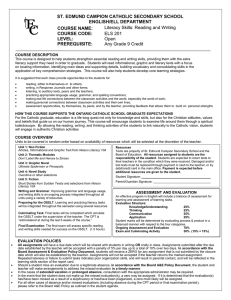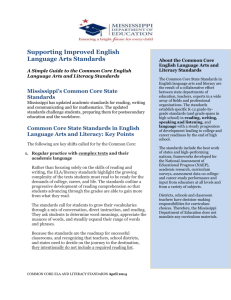Libraries and the Common Core
advertisement
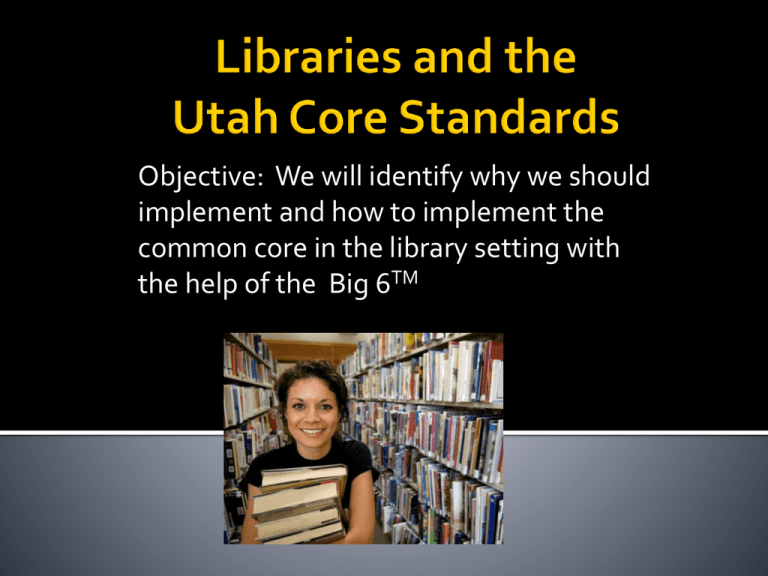
Objective: We will identify why we should implement and how to implement the common core in the library setting with the help of the Big 6TM Key Design Considerations of the Common Core Research and media skills blended into the Standards as a whole ▪ “The need to conduct research and to produce and consume media is embedded into every aspect of today’s curriculum. In like fashion, research and media skills and understandings are embedded throughout the Standards rather than treated in a separate section.” Students who are college and career ready in reading, writing, speaking, listening, and language can…. “…respond to the varying demands of audience, task, purpose, and discipline.” “…comprehend as well as critique.” (Analyze) “…value evidence.” (Cite Sources) “…use technology and digital media strategically and capably.” College and Career Readiness Anchor Standards for Writing (1) “…use valid reasoning and relevant and sufficient evidence.” (6) “Use technology, including the internet…” (7) “Conduct short as well as more sustained research projects based on focused questions, demonstrating understanding of the subject under investigation.” (8) “Gather relevant information from multiple print and digital sources, assess the credibility and accuracy of each source, and integrate the information while avoiding plagiarism.” (9) “Draw evidence from literary or informational texts to support analysis, reflection, and research.” Reading “…making an increasing number of connections among ideas and between texts, considering a wider rage of textual evidence….” Writing “…write about evidence from literary and informational texts. Because of the centrality of writing to most forms of inquiry, research standards are prominently included in this strand, though skills important to research are infused throughout the document.” Speaking and Listening “Students must learn to work together, express and listen carefully to ideas, integrate information from oral, visual, quantitative, and media sources, evaluate what they hear, use media and visual displays strategically to help achieve communicative purposes, and adapt speech to context and task.” Language “The vocabulary standards focus on understanding words and phrases…particularly general academic and domain-specific words and phrases.” 1. Write arguments to support claims in an analysis of substantive topics or texts, using valid reasoning and relevant and sufficient evidence. 7. Conduct short as well as more sustained research projects based on focused questions, demonstrating understanding of the subject under investigation. 8. Gather relevant information from multiple print and digital sources, assess the credibility and accuracy of each source, and integrate the information while avoiding plagiarism. 9. Draw evidence from literary or informational texts to support analysis, reflection, and research. 10. Write routinely over extended time frames (time for research, reflection, and revision) and shorter time frames (a single sitting or a day or two) for a range of tasks, purposed, and audiences. Students need to know how to extract information Use Wonderopolis on Pioneer for an easy lesson on extracting information Students need to know how to compare and contrast Use World Book on Pioneer (Explore, compare places) for an easy lesson on compare and contrast Students need to know how to organize information Do the old party game of items on a platter for an easy lesson on organizing information Students need to know how to evaluate their sources Do a lesson on Urban Legends Content or Concept Knowledge Weather Name the and climate different type of clouds. Comprehension Application Analysis Contrast the weather from the Southwest to the Southeast. What Create a effect did wind El Nino generator. have on the world’s weather? Chart the amount of rainfall for the next week. (Orlich, Harder, Callahan, Trevisan & Brown, 2013) Synthesis Three Strands Information Literacy Literature Media Literacy 1. Task Definition What am I doing and by when? 2. Information Seeking Strategies Make a plan! 3. Location and Access Find what you need for your project! 4. Use of Information Select and organize what you found! 5. Synthesis Make the project! 6. Evaluation Think again! How can I make it better? (The Big 6, 2012) I need to remember my task as I do the other steps! Use the Big 6 template for each lesson Focus on selecting and organizing information Magazine pictures ▪ ABC, story, size, some may edit List Game Focus on evaluation Make a check list in step two and use it in step six Allow enough time Plan Think of ideas Ask questions Make a list Do Get help or supplies Start the plan Review Check your list What would make it better for now or the next time? (The Big 6, 2012) PreK-1 Use a picture, stamp, icon, or sticker to identify type of source 1-2 In addition to the above, write the name of the type of source 2-3 Now add the author and no longer do the graphic 3-4 Add the date. The order is now: author, title, type of source, date. 5-6 Add location to the above (The Big 6, 2012) Double sided journals Instead of a research topic, give an essential question to the students Have students show a connection Include an application component to the research project Teaches students to identify key information and to extract it. Include a summary box Character Analysis How does knowing the character help the reader to predict? The big 6 (2012). Retrieved from http://big6.com The Council of chief State School Officers and the National Governors Association Center for Best Practices. (2010). Common core state standards for English language arts & literacy in history/social studies, science, and technical subjects. Orlich, D. C., Harder, R. J., Callahan, R. C., Trevisan, M. S., & Brown, A. H. (2013). Teaching strategies: A guide to effective instruction. (10 ed.). Belmont, CA: Wadsworth Cengage Learning. Utah State Office of Education. (2012). Core standards for English language arts and literacy in history/social studies, science, and technical subjects. Retrieved from http://www.schools.utah.gov/CURR/langartsec/Language-Arts-Secondary-Home/LangArts-CE-web.aspx



